1999 FORD F250 height
[x] Cancel search: heightPage 89 of 248
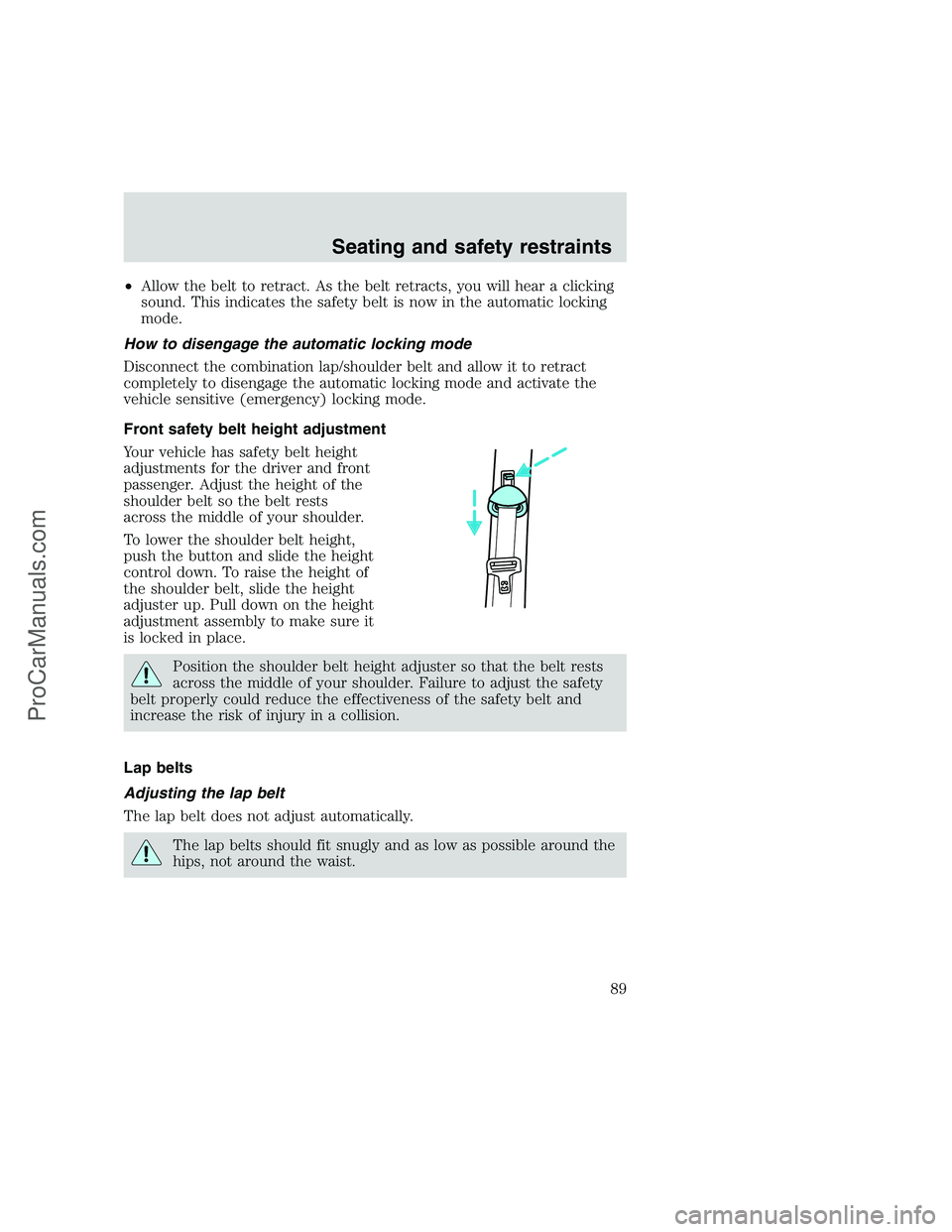
•Allow the belt to retract. As the belt retracts, you will hear a clicking
sound. This indicates the safety belt is now in the automatic locking
mode.
How to disengage the automatic locking mode
Disconnect the combination lap/shoulder belt and allow it to retract
completely to disengage the automatic locking mode and activate the
vehicle sensitive (emergency) locking mode.
Front safety belt height adjustment
Your vehicle has safety belt height
adjustments for the driver and front
passenger. Adjust the height of the
shoulder belt so the belt rests
across the middle of your shoulder.
To lower the shoulder belt height,
push the button and slide the height
control down. To raise the height of
the shoulder belt, slide the height
adjuster up. Pull down on the height
adjustment assembly to make sure it
is locked in place.
Position the shoulder belt height adjuster so that the belt rests
across the middle of your shoulder. Failure to adjust the safety
belt properly could reduce the effectiveness of the safety belt and
increase the risk of injury in a collision.
Lap belts
Adjusting the lap belt
The lap belt does not adjust automatically.
The lap belts should fit snugly and as low as possible around the
hips, not around the waist.
Seating and safety restraints
89
ProCarManuals.com
Page 91 of 248
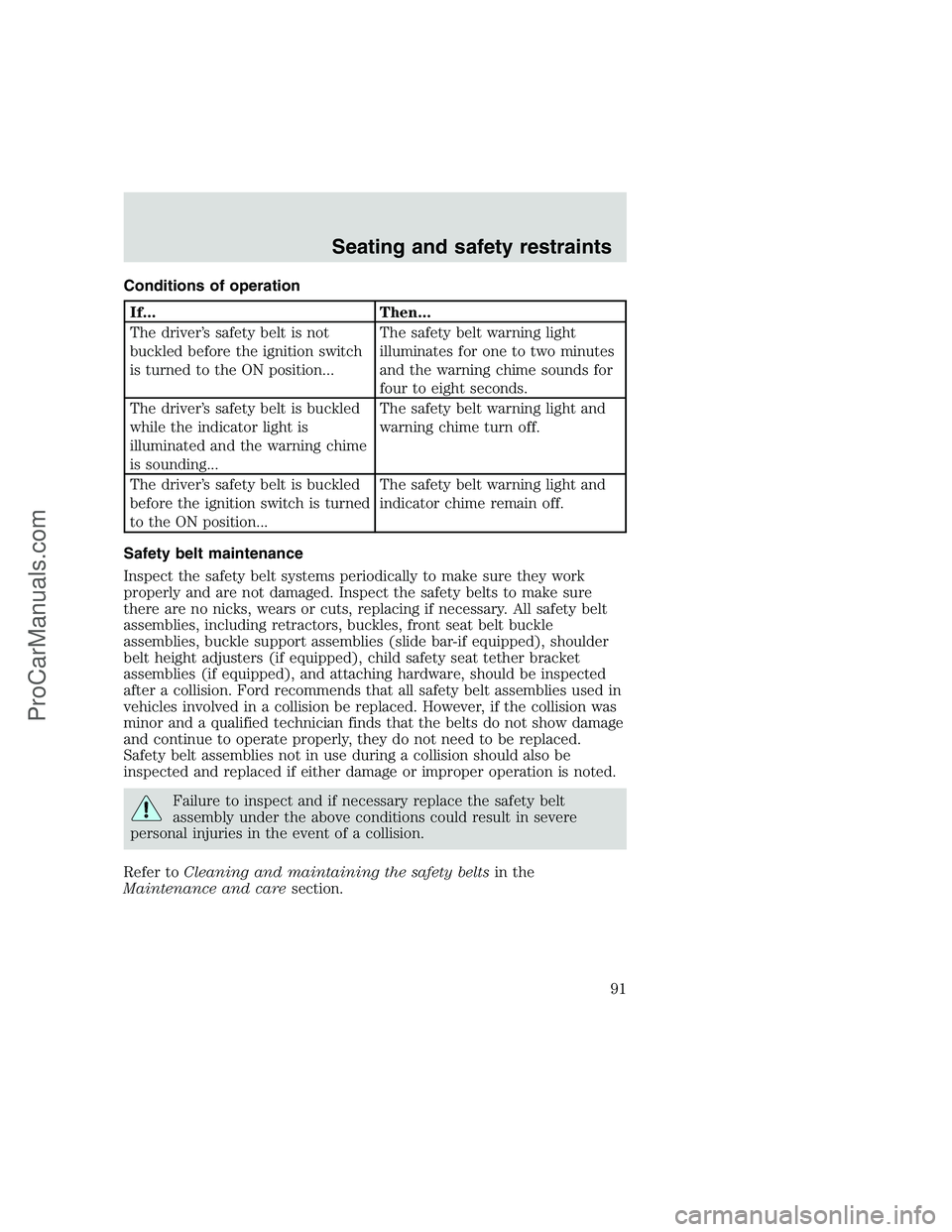
Conditions of operation
If... Then...
The driver’s safety belt is not
buckled before the ignition switch
is turned to the ON position...The safety belt warning light
illuminates for one to two minutes
and the warning chime sounds for
four to eight seconds.
The driver’s safety belt is buckled
while the indicator light is
illuminated and the warning chime
is sounding...The safety belt warning light and
warning chime turn off.
The driver’s safety belt is buckled
before the ignition switch is turned
to the ON position...The safety belt warning light and
indicator chime remain off.
Safety belt maintenance
Inspect the safety belt systems periodically to make sure they work
properly and are not damaged. Inspect the safety belts to make sure
there are no nicks, wears or cuts, replacing if necessary. All safety belt
assemblies, including retractors, buckles, front seat belt buckle
assemblies, buckle support assemblies (slide bar-if equipped), shoulder
belt height adjusters (if equipped), child safety seat tether bracket
assemblies (if equipped), and attaching hardware, should be inspected
after a collision. Ford recommends that all safety belt assemblies used in
vehicles involved in a collision be replaced. However, if the collision was
minor and a qualified technician finds that the belts do not show damage
and continue to operate properly, they do not need to be replaced.
Safety belt assemblies not in use during a collision should also be
inspected and replaced if either damage or improper operation is noted.
Failure to inspect and if necessary replace the safety belt
assembly under the above conditions could result in severe
personal injuries in the event of a collision.
Refer toCleaning and maintaining the safety beltsin the
Maintenance and caresection.
Seating and safety restraints
91
ProCarManuals.com
Page 138 of 248
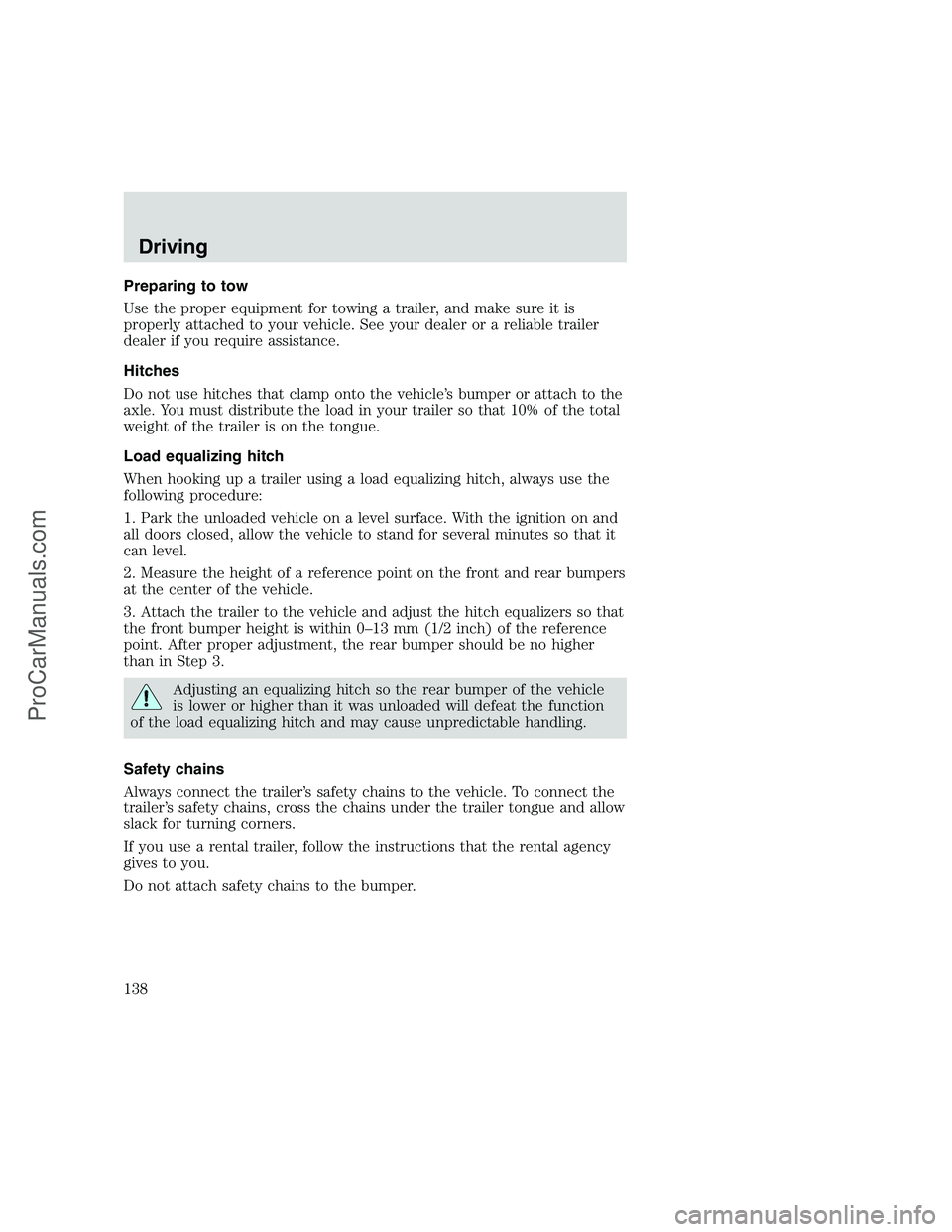
Preparing to tow
Use the proper equipment for towing a trailer, and make sure it is
properly attached to your vehicle. See your dealer or a reliable trailer
dealer if you require assistance.
Hitches
Do not use hitches that clamp onto the vehicle’s bumper or attach to the
axle. You must distribute the load in your trailer so that 10% of the total
weight of the trailer is on the tongue.
Load equalizing hitch
When hooking up a trailer using a load equalizing hitch, always use the
following procedure:
1. Park the unloaded vehicle on a level surface. With the ignition on and
all doors closed, allow the vehicle to stand for several minutes so that it
can level.
2. Measure the height of a reference point on the front and rear bumpers
at the center of the vehicle.
3. Attach the trailer to the vehicle and adjust the hitch equalizers so that
the front bumper height is within 0–13 mm (1/2 inch) of the reference
point. After proper adjustment, the rear bumper should be no higher
than in Step 3.
Adjusting an equalizing hitch so the rear bumper of the vehicle
is lower or higher than it was unloaded will defeat the function
of the load equalizing hitch and may cause unpredictable handling.
Safety chains
Always connect the trailer’s safety chains to the vehicle. To connect the
trailer’s safety chains, cross the chains under the trailer tongue and allow
slack for turning corners.
If you use a rental trailer, follow the instructions that the rental agency
gives to you.
Do not attach safety chains to the bumper.
Driving
138
ProCarManuals.com
Page 142 of 248
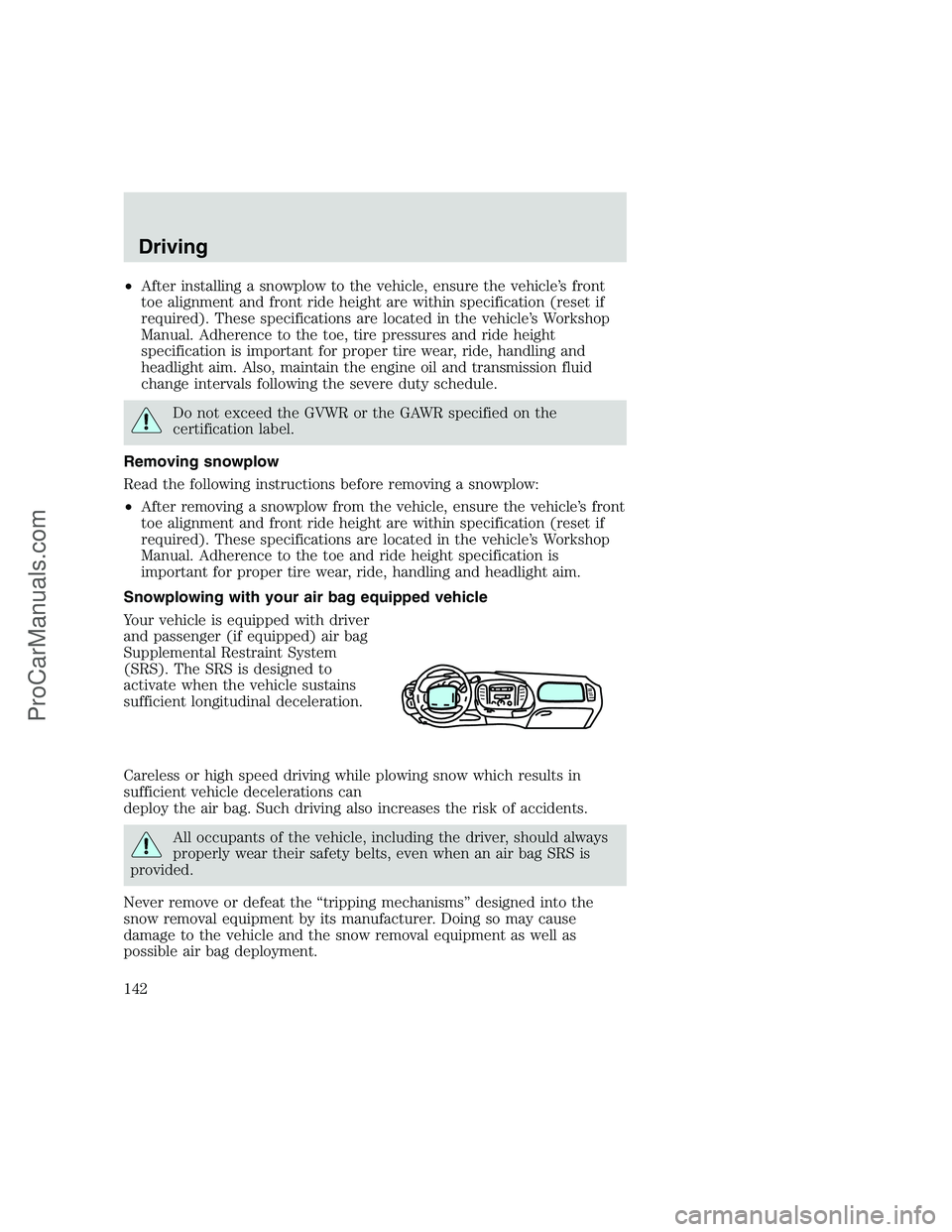
•After installing a snowplow to the vehicle, ensure the vehicle’s front
toe alignment and front ride height are within specification (reset if
required). These specifications are located in the vehicle’s Workshop
Manual. Adherence to the toe, tire pressures and ride height
specification is important for proper tire wear, ride, handling and
headlight aim. Also, maintain the engine oil and transmission fluid
change intervals following the severe duty schedule.
Do not exceed the GVWR or the GAWR specified on the
certification label.
Removing snowplow
Read the following instructions before removing a snowplow:
•After removing a snowplow from the vehicle, ensure the vehicle’s front
toe alignment and front ride height are within specification (reset if
required). These specifications are located in the vehicle’s Workshop
Manual. Adherence to the toe and ride height specification is
important for proper tire wear, ride, handling and headlight aim.
Snowplowing with your air bag equipped vehicle
Your vehicle is equipped with driver
and passenger (if equipped) air bag
Supplemental Restraint System
(SRS). The SRS is designed to
activate when the vehicle sustains
sufficient longitudinal deceleration.
Careless or high speed driving while plowing snow which results in
sufficient vehicle decelerations can
deploy the air bag. Such driving also increases the risk of accidents.
All occupants of the vehicle, including the driver, should always
properly wear their safety belts, even when an air bag SRS is
provided.
Never remove or defeat the “tripping mechanisms” designed into the
snow removal equipment by its manufacturer. Doing so may cause
damage to the vehicle and the snow removal equipment as well as
possible air bag deployment.
Driving
142
ProCarManuals.com
Page 217 of 248

ENGINE DATA
Engine 5.4L V8 engine 6.8L V10 engine
Cubic inches 330 415
Horsepower 235 @ 4250 rpm 275 @ 4250 rpm
Torque 335 lb.-ft. @ 3000 rpm 410 lb.-ft. @ 2650 rpm
Required fuel 87 octane 87 octane
Firing order 1-3-7-2-6-5-4-8 1-6-5-10-2-7-3-8-4-9
Spark plug gap1.3-1.4 mm
(0.052-0.056 inch)1.3-1.4 mm
(0.052-0.056 inch)
Ignition system Coil on plug Coil on plug
Compression ratio 9.0:1 9.0:1
VEHICLE DIMENSIONS
F250–except Crew cab
Dimension Body style
Regular
Cab 4x2Regular
Cab 4x4Super Cab
4x2Super Cab
4x4
(1) Overall
height1 864 mm
(74 in)1 958 mm
(77.1 in)1 870 mm
(73.6 in)1 964 mm
(77.3 in)
(2) Track
(Front /
Rear)1 736.3 mm
(68.3 in) /
1 729.3 mm
(68 in)1 736.3 mm
(68.3 in) /
1 729.3 mm
(68 in)1 736.3 mm
(68.3 in) /
1 729.3 mm
(68 in)1 736.3 mm
(68.3 in) /
1 729.3 mm
(68 in)
(3) Overall
width2 031 mm
(79.9 in)2 031 mm
(79.9 in)2 031 mm
(79.9 in)2 031 mm
(79.9 in)
(4)
Wheelbase3 479.8 mm
(137 in)3 479.8 mm
(137 in)3 601.7 mm
(141.8 in)
a
4 013.2 mm
(158 in)b
3 601.7 mm
(141.8 in)a
4 013.2 mm
(158 in)b
(5) Overall
length5 646 mm
(222.2 in)5 757 mm
(226.6 in)5 876 mm
(231.3 in)a
6 177 mm
(243.1 in)b
5 879 mm
(231.4 in)a
6 180 mm
(243.3 in)b
a
Short wheel basebLong wheel base
Capacities and specifications
217
ProCarManuals.com
Page 218 of 248

F250-Crew cab
Dimension Body style
Crew Cab 4x2 Crew Cab 4x4
(1) Overall height 1 960 mm (77.2 in)
a/
1 883 mm (74.1 in)b2 053mm (80.8 in)a/
2 052 mm (80.8 in)b
(2) Track (Front /
Rear)1 745 mm (68.7 in)/
1 729 mm (68.1 in)a,b1 736 mm (68.4 in)/
1 729 mm (68.1 in)a,b
(3) Overall width 1 988 mm (78.3 in)a,b1 988 mm (78.3 in)a,b
(4) Wheelbase 3 967 mm (156.2 in )a/
4 379 mm (172.4 in)b3 967 mm (156.2 in )a/
4 379 mm (172.4 in)b
(5) Overall length 6 242 mm (245.8 in)a/
6 654 mm (262.0 in)b6 242 mm (245.8 in)a/
6 654 mm (262.0 in)b
a
Short wheel basebLong wheel base
F350–except Crew cab
Dimension Body style
Chassis
CabRegular
CabSuper Cab
4x2Super Cab
4x4
(1) Overall
height1 972 mm
(77.6 in)1 860 mm
(73.2 in)
c,e1 865 mm
(73.4 in)a
1 861 mm
(73.6 in)b
1 960 mm
(77.2 in)
(2) Track
(Front /
Rear)1 736.3 mm
(68.3 in) /
1 879.6 mm
(74.0 in)1 736.3 mm
(68.3 in) /
1 729.3 mm
(68.0 in)1 736.3 mm
(68.3 in) /
1 729.3 mm
(68.0 in)
a,c
1 736.3 mm
(68.3 in) /
1879.6 mm
(74.0 in)
b,d
1 737.3 mm
(68.4 in) /
1 729.3 mm
(68.0 in)
(3) Overall
width2 025 mm
(79.7 in)2 031 mm
(79.9 in)2 031 mm
(79.9 in)2 031 mm
(79.9 in)
(4) Wheel-
base3 576.3 mm
(140.8 in)3 479.8 mm
(137.0 in)3 601 mm
(141.8 in)
a/
4 013.2 mm
(158.0 in)
b
3 601 mm
(141.8 in)a/
4 013.2 mm
(158.0 in)
b
Capacities and specifications
218
ProCarManuals.com
Page 219 of 248
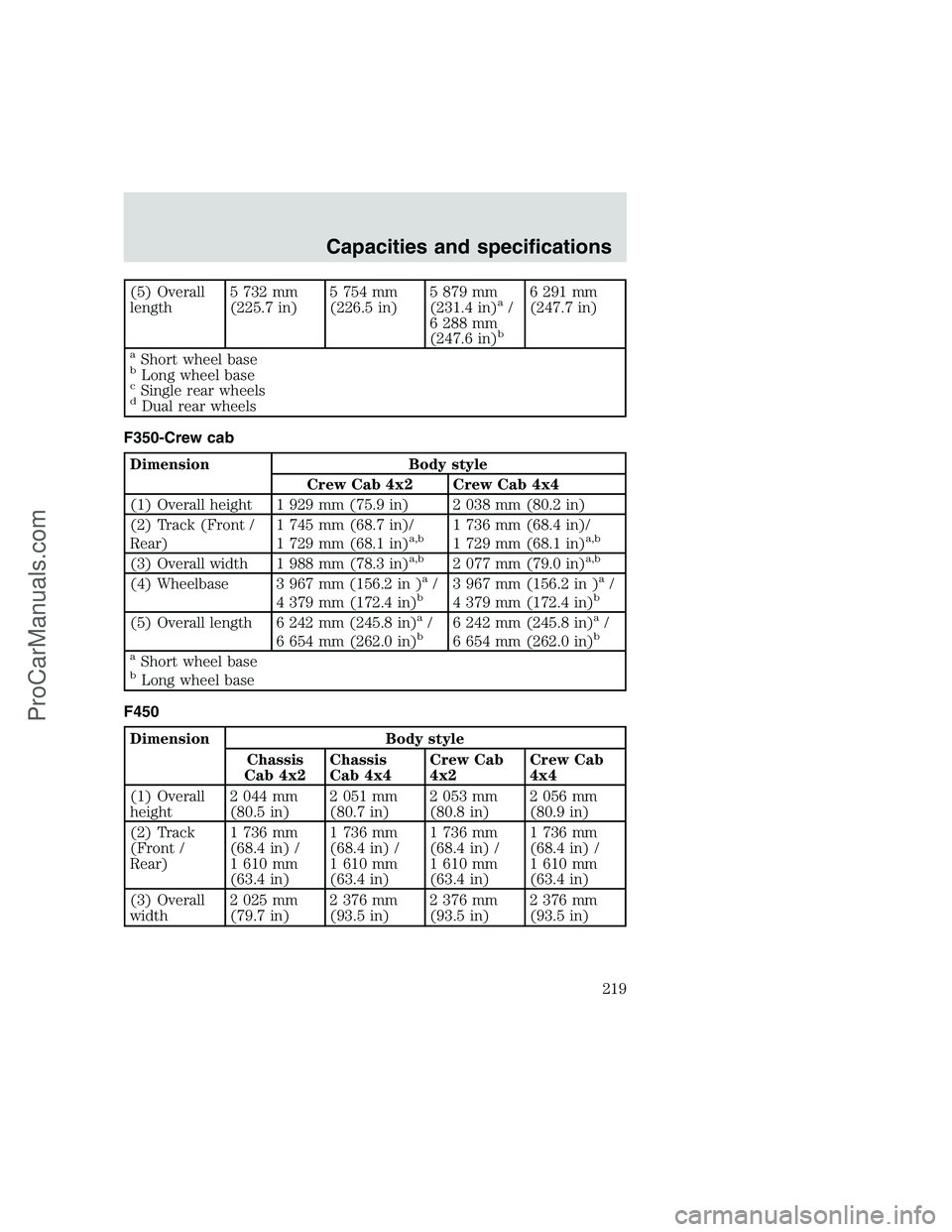
(5) Overall
length5 732 mm
(225.7 in)5 754 mm
(226.5 in)5 879 mm
(231.4 in)a/
6 288 mm
(247.6 in)
b
6 291 mm
(247.7 in)
aShort wheel basebLong wheel basecSingle rear wheelsdDual rear wheels
F350-Crew cab
Dimension Body style
Crew Cab 4x2 Crew Cab 4x4
(1) Overall height 1 929 mm (75.9 in) 2 038 mm (80.2 in)
(2) Track (Front /
Rear)1 745 mm (68.7 in)/
1 729 mm (68.1 in)
a,b1 736 mm (68.4 in)/
1 729 mm (68.1 in)a,b
(3) Overall width 1 988 mm (78.3 in)a,b2 077 mm (79.0 in)a,b
(4) Wheelbase 3 967 mm (156.2 in )a/
4 379 mm (172.4 in)b3 967 mm (156.2 in )a/
4 379 mm (172.4 in)b
(5) Overall length 6 242 mm (245.8 in)a/
6 654 mm (262.0 in)b6 242 mm (245.8 in)a/
6 654 mm (262.0 in)b
a
Short wheel basebLong wheel base
F450
Dimension Body style
Chassis
Cab 4x2Chassis
Cab 4x4Crew Cab
4x2Crew Cab
4x4
(1) Overall
height2 044 mm
(80.5 in)2 051 mm
(80.7 in)2 053 mm
(80.8 in)2 056 mm
(80.9 in)
(2) Track
(Front /
Rear)1 736 mm
(68.4 in) /
1 610 mm
(63.4 in)1 736 mm
(68.4 in) /
1 610 mm
(63.4 in)1 736 mm
(68.4 in) /
1 610 mm
(63.4 in)1 736 mm
(68.4 in) /
1 610 mm
(63.4 in)
(3) Overall
width2 025 mm
(79.7 in)2 376 mm
(93.5 in)2 376 mm
(93.5 in)2 376 mm
(93.5 in)
Capacities and specifications
219
ProCarManuals.com
Page 220 of 248
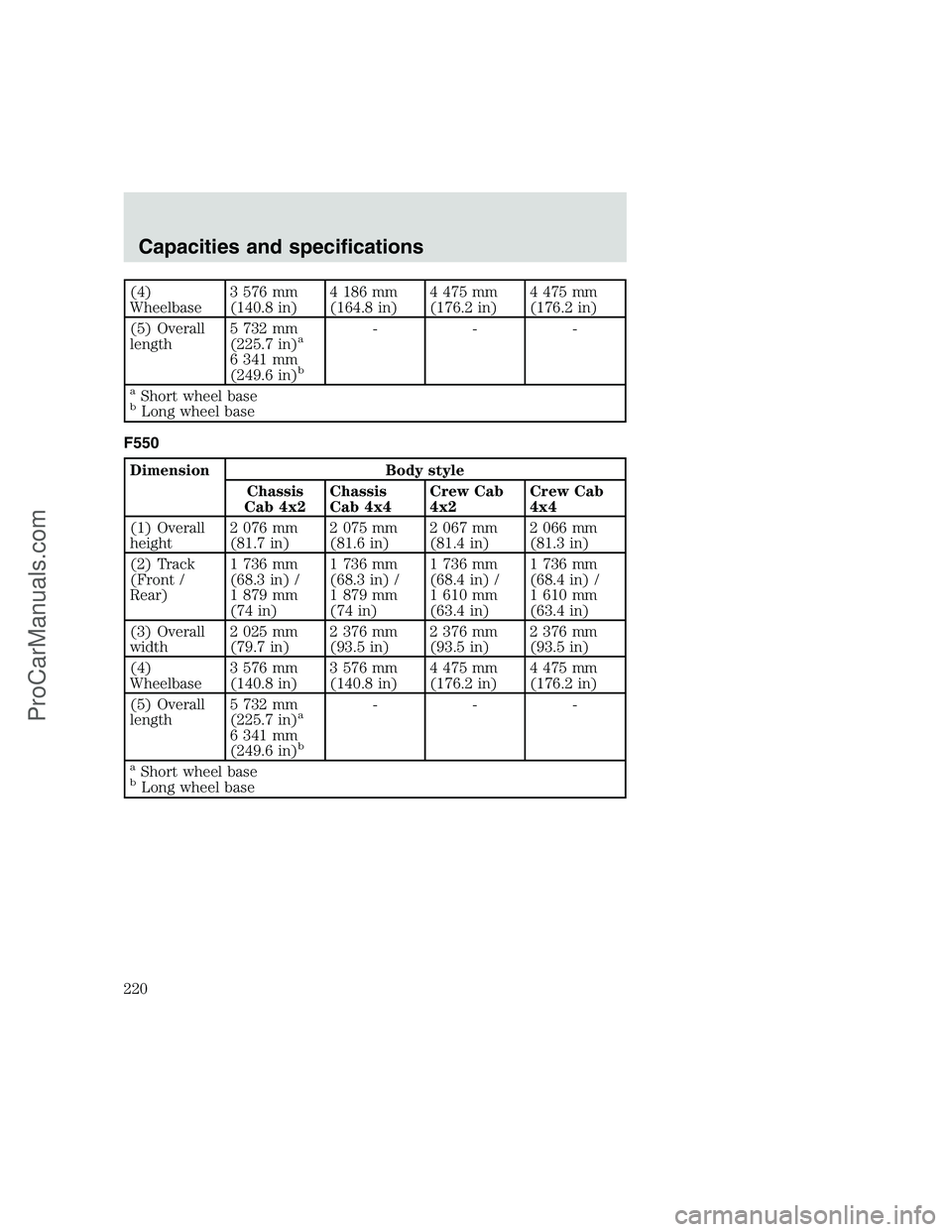
(4)
Wheelbase3 576 mm
(140.8 in)4 186 mm
(164.8 in)4 475 mm
(176.2 in)4 475 mm
(176.2 in)
(5) Overall
length5 732 mm
(225.7 in)
a
6 341 mm
(249.6 in)b
---
aShort wheel basebLong wheel base
F550
Dimension Body style
Chassis
Cab 4x2Chassis
Cab 4x4Crew Cab
4x2Crew Cab
4x4
(1) Overall
height2 076 mm
(81.7 in)2 075 mm
(81.6 in)2 067 mm
(81.4 in)2 066 mm
(81.3 in)
(2) Track
(Front /
Rear)1 736 mm
(68.3 in) /
1 879 mm
(74 in)1 736 mm
(68.3 in) /
1 879 mm
(74 in)1 736 mm
(68.4 in) /
1 610 mm
(63.4 in)1 736 mm
(68.4 in) /
1 610 mm
(63.4 in)
(3) Overall
width2 025 mm
(79.7 in)2 376 mm
(93.5 in)2 376 mm
(93.5 in)2 376 mm
(93.5 in)
(4)
Wheelbase3 576 mm
(140.8 in)3 576 mm
(140.8 in)4 475 mm
(176.2 in)4 475 mm
(176.2 in)
(5) Overall
length5 732 mm
(225.7 in)
a
6 341 mm
(249.6 in)b
---
aShort wheel basebLong wheel base
Capacities and specifications
220
ProCarManuals.com